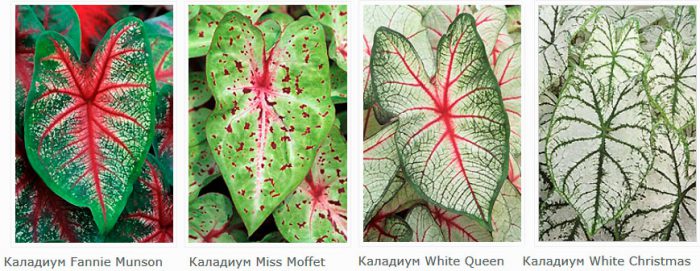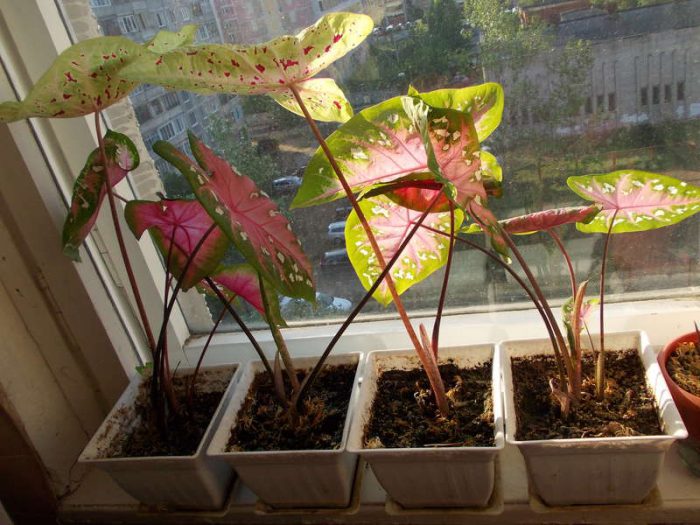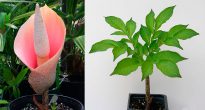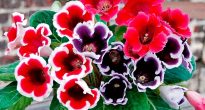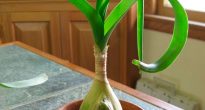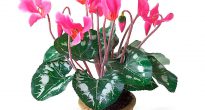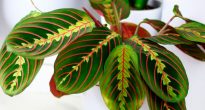A plant like Caladium (Caladium) is directly related to the Araceae family. In natural conditions, it can be found in Brazil, but it prefers to grow on the shores of the Amazon.
Caladium can reach a height of 5 meters, but this is only in natural conditions, or rather, in tropical rainforests. This herbaceous plant, which is tuberous, is quite large in size. It has large arrow-shaped leaves, and it is thanks to them that it is also called "elephant ears". In Brazil, caladium is an agricultural crop from which starch is produced.
In this plant, attention is drawn to its very spectacular leaves, on the surface of which incredible patterns flaunt, consisting of veins of various colors, multi-colored borders, specks, as well as transitions from one color shade to another. As a rule, the leaves of caladium are colored in such color combinations as: silver, crimson, various shades of green, white, pink and purple. The leaves are arrow-shaped, triangular, pointed, and also heart-shaped.
The flowers of this plant, like that of a large number of aroids, do not represent any decorative value. Nondescript-looking flowers are collected in inflorescences in the form of an cob, which is surrounded by a white-green veil.
Currently, flower shops sell caladiums, which are hybrids created by crossing several species. Each individual hybrid has its own individual coloration and unique patterns.
Such a plant, despite its spectacular appearance, did not win the love of a large number of florists, and this is due to the long period of deep rest. Since this is a tuberous plant, it has 2 clearly defined periods: dormancy and intensive growth. With the onset of autumn, Caladium leaves fall off, and it comes to life only in the last weeks of February.
However, not for everyone, a long period of rest is certainly a disadvantage. For example, such a flower is perfect for cramped apartments, which have a loggia, a glazed balcony or a spacious veranda. The fact is that in winter there is not enough space for large flowers in the apartment. However, in the warm season, its area increases significantly. Caladium can be put in the pantry for the winter, and with the onset of spring it will start to grow. It should be borne in mind that the leaves grow quite quickly.
It is important to remember that the juice of this plant, found in any part of it, is poisonous, and it can provoke allergies. Therefore, it is not recommended to place Caladium in children's rooms.
Content
Caring for Caladium at Home
This plant is not much different from other tropical plants. It is warm and moisture-loving, does not tolerate cold drafts, as well as direct sunlight.
Illumination
Recommended to be placed on windows located in the western or eastern part of the room. Caladium needs bright, but always diffused light. If there is little light, then the leaves will become pale.
Temperature regime
Loves warmth very much. During growth and development, it should be in a room with a temperature of 20 to 25 degrees. And the room where the plant is stored during the dormant period should not be colder than 20 degrees. It is also protected from sudden temperature changes, as well as from drafts.
Humidity
Requires high humidity. Systematic cleaning of foliage from dust is required.
How to water
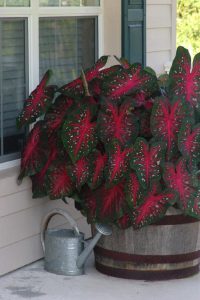 Since this plant is a marsh plant, it needs abundant, but even watering. In this case, the substrate should be breathable and coarse fiber, as this will allow excess liquid to drain quickly. If acidification occurs, then the caladium will lose both foliage and roots.
Since this plant is a marsh plant, it needs abundant, but even watering. In this case, the substrate should be breathable and coarse fiber, as this will allow excess liquid to drain quickly. If acidification occurs, then the caladium will lose both foliage and roots.
With the onset of autumn, watering the flower gradually decreases, and then stops altogether. After the foliage dries, the tubers will need to be pulled out of the pot, the soil and old roots removed from them, and removed for storage. You can store the flower in a pot.
Very important! Plants often die due to mistakes made during their awakening after a dormant period. When caladium has only a growing bud and there are no bulky leaves, it should be watered sparingly. The fact is that the root system, which absorbs moisture, has not yet formed, there is no foliage that evaporates water, and therefore the tuber, being in too damp soil, begins to rot quickly.
Top dressing
The plant is fed during the period of intensive growth 2 or 3 times in 4 weeks. For this, liquid mineral fertilizer is used.
Transplant features
A transplant into a new pot is carried out in the last winter weeks, after the growth bud swells. As a rule, the tubers below are smooth, there are no shoots in this part. In the event that the flower is planted "upside down", then this will not destroy it, but will cause stunted foliage growth.
A good drainage layer is a must during transplanting. If the tuber is not deeply buried, then this will provoke the formation of young shoots, but the leaves will not be so large. When planted deeply, the flower produces rather large leaves and tubers.
Earth mix
The land for planting Caladium should be loose and light, and also perfectly permeable to moisture. To create a suitable soil mixture, you need to mix leaf earth, coconut fiber (can be replaced with high moor peat) and perlite in a ratio of 4: 2: 1.
Dormant period
This plant simply needs a deep dormant period. With the onset of the autumn period, watering should be gradually reduced. And then they stop watering the plant altogether. Dried leaves should be removed. Tubers for wintering can be left in the same pot with soil, but no need to water. At the end of winter, or rather, in February, they should be removed from the soil, removed old roots and planted in a new soil mixture. Watering should be sparse at first. When leaves appear, watering should be gradually increased. Dry peat or coconut fiber is excellent for storing tubers.
Reproduction methods
For reproduction, medium-sized daughter tubers are used.
The tuber can be divided if necessary, but it should be borne in mind that it can rot. The place of the cut must be processed with crushed charcoal, dried, and then planted in an earth mixture.
Experienced growers also recommend cutting off the main point of growth from a large tuber. After 2 weeks, other buds are formed, after which the tuber is planted.Until autumn, the tuber must independently separate into several parts.
If the tuber is not buried during planting, then children will form in it (not always).
Pests and diseases
Resistant to pests. Any part of the plant can easily rot. As a preventive measure, a systematic examination is recommended.
If rot is formed on the tuber, then it should be cut out. After that, the tuber is immersed in a solution of Trichopolum (Metronidazole). Then they are treated with charcoal and planted in sphagnum moss until the roots appear. Then they cover it with soil.


